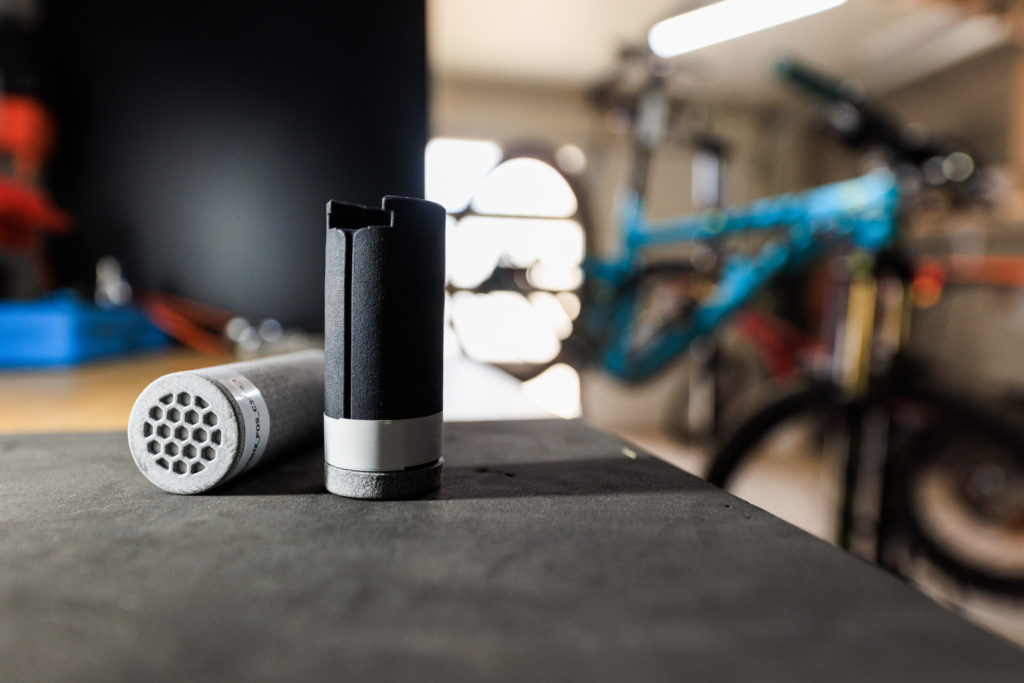After extensive laboratory testing, Carbon Air’s TruTune activated carbon inserts for mountain bikes have entered a key development trial phase. Led by former MotoGP and Grand Prix KTM suspension engineer, Kevin Harris, the Carbon Air development team kicked off the test programme in Sedona, Arizona, taking a major step towards TruTune technology entering commercial production. A short video detailing the testing can be found here: https://vimeo.com/662975183
Carbon Air’s technology transforms the tunability of mountain bike shocks and forks. Activated carbon can reduce the stiffness of compressed air, allowing an air spring to behave in a more linear way and improve ride performance within a more compact package.
For keen mountain bike riders, TruTune promises to deliver an unprecedented level of tunability for spring rate progression and damper settings, and the capability to adjust sag and shock stiffness independently of each other for the first time.

Kevin Harris, Development and Test Engineer at Carbon Air, commented; “We had a great few days in Arizona testing the inserts on some truly exhilarating trails for the first time. As predicted from the data recorded from the bike acquisition equipment, we found an overall improvement of the ride in all aspects of these challenging conditions – you could really feel the difference.
“The R&D team have been working for over a year to develop specific activated carbon compositions for mountain bikes, but to feel the change in the suspension out riding is the real test. Experiencing the difference on the trails compared to riding without the insert was fantastic.”
Riding alongside Kevin Harris was Keith Griffiths, a local Sedona resident, experienced trail guide and test rider. Griffiths commented: “When I first heard about TruTune and the way it changes the behaviour of air, my immediate reaction was of disbelief! When I was given the opportunity to ride out in Sedona with Kevin and help in the testing process, I got the chance to feel the insert working on landing and throughout the harsh terrain. It is a very impressive product.”

John Coakley, CTO of Carbon Air “The test riders captured a huge amount of data out in Arizona that we’ve already started analysing in the lab in Manchester. And that is helping us further refine TruTune and take a major step closer to fitting it into a production bike. We can’t wait for riders around the world to experience how our activated carbon can seemingly bend the laws of physics.”
Riders know about the weight and tunability advantages that air springs offer. Compared to coil springs though, the most discerning riders consider that air springs lack support in the mid stroke and can be too firm off the top. Carbon Air technology enables the performance of air suspension to be modified to achieve increased or reduced stiffness, raised or lowered sag and improved progression, all within a more compact package. Carbon Air has developed varieties of activated carbon that have a fast response, high stiffness reduction and low temperature sensitivity.
The effect of activated carbon not only decreases the stiffness of air suspension and improves linearity but also helps achieve better grip, greater impact absorption, and a reduction in vibrations transmitted to the handlebars.
What is activated carbon and how does it work?
The properties of gas in a cavity are widely understood to be unchangeable, so to modify the stiffness in an air spring for equal charge pressure according to the rider’s needs would require alteration of the inner geometry in the compression chamber. Carbon Air’s activated carbon technology solves this, through the power of adsorption.
Micropores within activated carbon exhibit a high surface area of over a thousand metres per gram. The material adsorbs air molecules to its surface, effectively ‘storing’ large amounts of gas that form a film on the vast solid surface area.
The result is a dramatic change of the pressure curve. Just as increased pressure causes adsorption, decreased pressure causes desorption, and so the changes in pressure with compression and extension of the spring are counteracted. The effect is that the suspension behaves as if it has a larger volume, reducing stiffness and increasing linearity, without impacting the charge pressure or ride height.
Each unit of volume occupied by the activated carbon approximately doubles the air capacity.
Activated carbon is formed by subjecting organic carbon matter, such as coconut shells, coal and sawdust, to super-heated steam and chemicals. This process creates a dense network of microscopic pores, which can vary in type according to the source material being converted. These differences cause significantly differing adsorption behaviour, which can be enhanced and tuned to a particular application.
Traditionally, activated carbon has been used for gas and liquid filtration, and is used extensively in the water treatment and food industries. But the use of the material to moderate the mechanical behaviour of air has been pioneered by Carbon Air, and the technical opportunities are significant.
